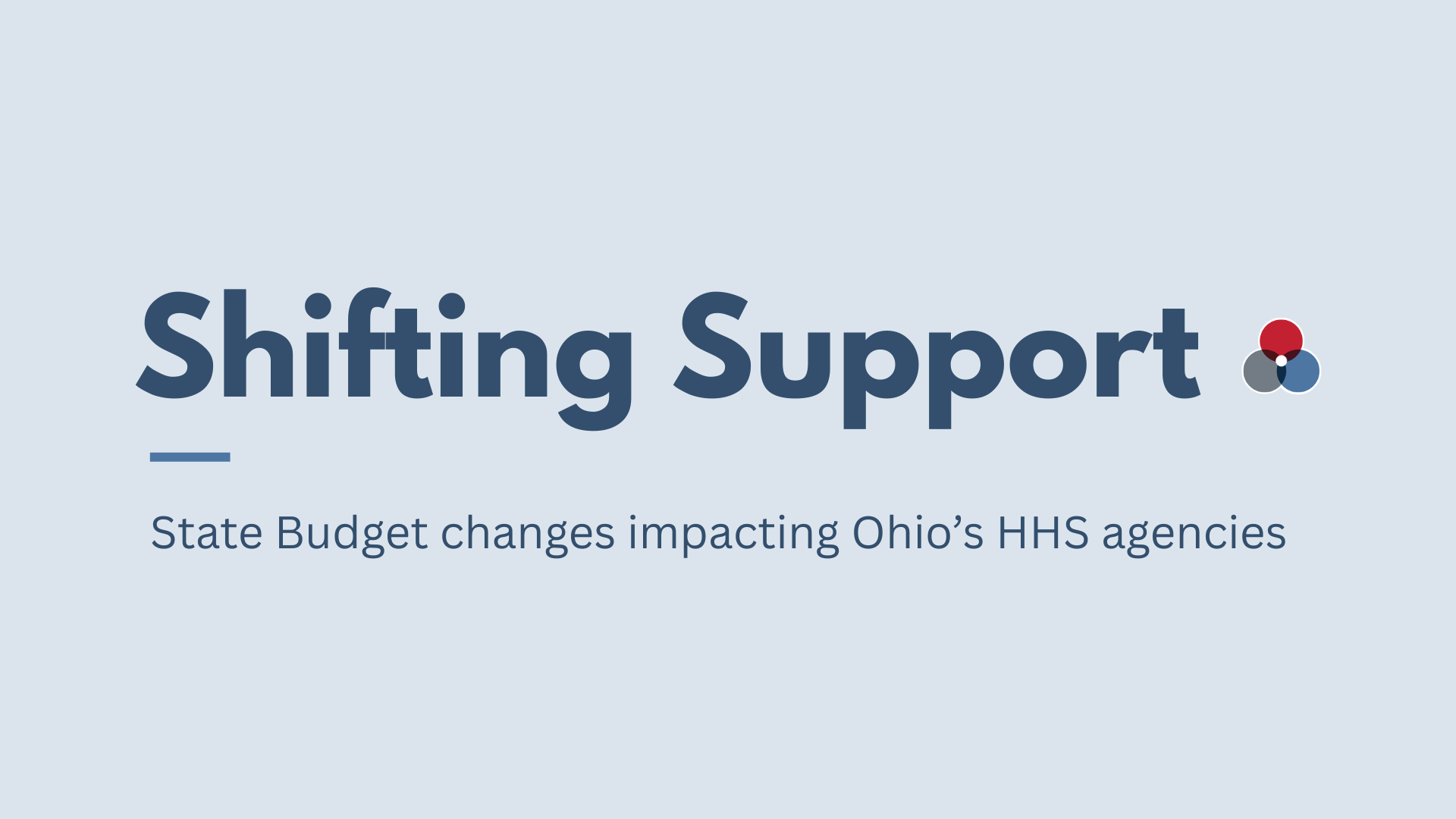The Ohio Department of Mental Health and Addiction Services (MHAS) is the state agency responsible for the state’s system of local alcohol, drug addiction, and mental health services (ADAMHS) boards and licensing behavioral health service providers, as well as operating the state’s psychiatric hospitals. As we continue to deal with the COVID-19 public health emergency and the impacts felt across every sector, the overall mental health of Ohioans, as well as ensuring there is a workforce available to provide services, must be priorities. The state budget funds myriad initiatives aimed at improving access to treatment for and early detection and prevention of behavioral health disorders. This edition of State Budgeting Matters will take a look at some of the newer sources of funding and key focus areas of the agency, but it doesn’t cover all of the work happening at MHAS.[1]
Ohioans with Complex Needs Spanning Multiple Public Systems
The Center for Community Solutions advocated for the full implementation of the Multi-System Youth (MSY) Action Plan during 2022-23 budget deliberations and for the budget language and funding to support implementation of OhioRISE (Resilience through Integrated Systems and Excellence) that would bring coordinated care to youth with complex, cross-systems needs through a specialized Medicaid program. Read more about OhioRISE here. Through its budget initiatives, MHAS dedicated dollars and programming to adults with similar complex, cross-systems needs, otherwise known as multi-system adults. The MHAS budget dedicates $5.5 million each year to developing a strategy for cross-systems collaboration to address the needs of multi-system adults. MHAS is a partner in the overall OhioRISE work, and ultimately the goal will be for a more streamlined transition for MSY once they reach adulthood. Strategic planning for multi-system adults could go a long way in easing this transition and provide more coordinated services for individuals who are currently in adulthood and struggling with a piecemeal system of services.
The MHAS budget dedicates $5.5 million each year to developing a strategy for cross-systems collaboration to address the needs of multi-system adults.
A small, but key provision in the MHAS budget moves the Ohio Family and Children First (OFCF) from MHAS to the Department of Job and Family Services (JFS). The OFCF is a cross-agency collaboration aimed at streamlining public services and supports for families and children. The OFCF works with a system of 88 county-level Family and Children First Councils (FCFC). Moving the OFCF to JFS will better incorporate it into the work to implement the federal Family First Prevention Services Act (Family First), which focuses on an evidence-based prevention first model to reduce the need for foster care placements and ensure children in foster care are being cared for in the most appropriate setting. The Family First work is being led by JFS in Ohio, but is a cross-agency initiative, like OFCF.
Workforce Initiatives
Workforce challenges are widespread across an array of industries, and the behavioral health system is not immune. Really, the issue has been longstanding in the behavioral health community, but with increased demand in light of COVID-19 and the implementation of a numbers of initiatives focused on increasing accessing to behavioral health services, time is of the essence. There are cross-agency initiatives to address the workforce shortages, and dedicated funds in the MHAS budget specifically for efforts around the behavioral health workforce challenges. There is $3.5 million in each year of the budget for MHAS driven workforce initiatives, as well as $5 million per year that is going directly to community behavioral health organizations to support workforce retention and recruitment.
A significant amount of federal dollars is dedicated to addressing the impacts of opioid addiction through the State Opioid Response Grant, to the tune of $110.2 million in each year of the budget.
Opioid Crisis
While we’ve spent the last 18 months in the midst of a public health crisis due to COVID-19, the pernicious and persistent opioid crisis has not subsided, and in fact was exacerbated by the effects of COVID-19’s social distancing and mental health challenges. MHAS has many ongoing efforts to address addiction that are sustained in this budget, including through the work of local ADAMHS boards and the state’s collaboration with the prison system to provide care for addiction. A significant amount of federal dollars is dedicated to addressing the impacts of opioid addiction through the State Opioid Response Grant, to the tune of $110.2 million in each year of the budget. Ohio’s State Opioid Response plan is available here.
Harm Reduction
Funding to support harm reduction, broadly, is included in both the MHAS budget, as well as the budget for the Ohio Department of Health (ODH). There are dollars within the State Opioid Response Grant to provide access to naloxone to reverse overdoses, as well as support for fentanyl education campaigns, to raise awareness about the threat of fentanyl. ODH specifically supports harm reduction in the form of funding for syringe services programs. The harm reduction funding in the ODH budget is $50,000 per year allocated to local public health agencies that are accredited or in the process of becoming accredited.[2] Community Solutions has supported the use of these dollars at the community level as syringe service programs are proven to reduce the transmission of disease and offer a connection to services for people struggling with substance use disorders.
The need for mental health and substance use disorder services has increased during a time when we have all been dealing with a nearly unprecedented public health crisis and it is critical that the state fully assess if services are available to everyone who needs them.
Ohioans in Crisis
The MHAS budget invests in behavioral health crisis services in multiple ways, through hospital services, local ADAMHS board funding, and a dedicated effort to invest up to $2.5 million in each year of the budget “to develop, evaluate, and expand crisis services” across all age groups. While certainly different in the manifestations, mental health and substance use disorder crises are as significant as physical health crises and need to be available to all Ohioans. The need for mental health and substance use disorder services has increased during a time when we have all been dealing with a nearly unprecedented public health crisis and it is critical that the state fully assess if services are available to everyone who needs them. While racial disparities in incidence and access to treatment for behavioral health disorders are longstanding, the pandemic has amplified the disparities. While the incidence of suicide among Black youth has been on the rise, a recently released report shows that starkest increase in suicide rates has been among Black girls.[3] Strategies to specifically address these disparities must be a part of the state’s overall crisis-focused work.
Conclusion
While the nation and state look ahead to both the public health and economic recovery, the work of MHAS is imperative to ensuring the overall health of Ohioans. Community Solutions will continue to closely track the implementation of OhioRISE and work to elevate the voices of people most impacted by mental health and substance use disorders.[1] Ohio Legislative Service Commission. (2021, August). Greenbook LBO Analysis of Enacted Budget: Ohio Department of Mental Health and Addiction Services. https://www.lsc.ohio.gov/documents/budget/134/MainOperating/greenbook/MHA.[2] Ohio Legislative Service Commission. (2021, August). Greenbook LBO Analysis of Enacted Budget: Ohio Department of Health. https://www.lsc.ohio.gov/documents/budget/134/MainOperating/greenbook/DOH.PDF.[3] Caron, C. 'What’s Going on With Our Black Girls?’ Experts Warn of Rising Suicide Rates. The New York Times. https://www.nytimes.com/2021/09/10/well/mind/suicide-rates-black-girls.html








